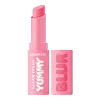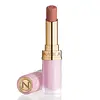What's inside
What's inside
 Key Ingredients
Key Ingredients

 Benefits
Benefits

 Concerns
Concerns

 Ingredients Side-by-side
Ingredients Side-by-side

Dimethicone
EmollientC12-15 Alkyl Benzoate
AntimicrobialOctyldodecanol
EmollientSilica
AbrasiveSynthetic Wax
AbrasiveMica
Cosmetic ColorantHydrogenated Polyisobutene
EmollientCandelilla Cera
EmollientPolysilicone-11
Squalane
EmollientDimethicone/Vinyl Dimethicone Crosspolymer
Skin ConditioningPolyphenylsilsesquioxane
Punica Granatum Sterols
Skin ConditioningVitis Vinifera Seed Oil
EmollientSqualene
EmollientCaprylyl Glycol
EmollientParfum
MaskingCocos Nucifera Oil
MaskingMedicago Sativa Extract
TonicStevia Rebaudiana Leaf/Stem Extract
MaskingCI 45410
Cosmetic ColorantCI 15850
Cosmetic ColorantDimethicone, C12-15 Alkyl Benzoate, Octyldodecanol, Silica, Synthetic Wax, Mica, Hydrogenated Polyisobutene, Candelilla Cera, Polysilicone-11, Squalane, Dimethicone/Vinyl Dimethicone Crosspolymer, Polyphenylsilsesquioxane, Punica Granatum Sterols, Vitis Vinifera Seed Oil, Squalene, Caprylyl Glycol, Parfum, Cocos Nucifera Oil, Medicago Sativa Extract, Stevia Rebaudiana Leaf/Stem Extract, CI 45410, CI 15850
Dimethicone
EmollientSynthetic Wax
AbrasiveIsononyl Isononanoate
EmollientDimethicone/Vinyl Dimethicone Crosspolymer
Skin ConditioningCaprylic/Capric Triglyceride
MaskingBis-Diglyceryl Polyacyladipate-2
EmollientIsostearyl Isostearate
EmollientDiisostearyl Malate
EmollientLauroyl Lysine
Skin ConditioningCera Microcristallina
Emulsion StabilisingPolybutene
Dicalcium Phosphate
AbrasiveSynthetic Beeswax
Emulsion StabilisingAroma
Disteardimonium Hectorite
StabilisingPentaerythrityl Tetra-Di-T-Butyl Hydroxyhydrocinnamate
AntioxidantPropylene Carbonate
SolventCI 77891
Cosmetic ColorantCI 77491
Cosmetic ColorantCI 77492
Cosmetic ColorantCI 42090
Cosmetic ColorantCI 15850
Cosmetic ColorantDimethicone, Synthetic Wax, Isononyl Isononanoate, Dimethicone/Vinyl Dimethicone Crosspolymer, Caprylic/Capric Triglyceride, Bis-Diglyceryl Polyacyladipate-2, Isostearyl Isostearate, Diisostearyl Malate, Lauroyl Lysine, Cera Microcristallina, Polybutene, Dicalcium Phosphate, Synthetic Beeswax, Aroma, Disteardimonium Hectorite, Pentaerythrityl Tetra-Di-T-Butyl Hydroxyhydrocinnamate, Propylene Carbonate, CI 77891, CI 77491, CI 77492, CI 42090, CI 15850
Ingredients Explained
These ingredients are found in both products.
Ingredients higher up in an ingredient list are typically present in a larger amount.
Ci 15850 is the pigment color red. It is an azo dye and created synthetically.
Azo dyes need to be thoroughly purified before use. This allows them to be more stable and longer-lasting.
This ingredient is common in foundations, lipsticks, and blushes. This color is described as brown/orangey red.
It has many secondary names such as Red 6 and Red 7. According to a manufacturer, Red 6 usually contains aluminum.
Learn more about CI 15850Dimethicone is a type of synthetic silicone created from natural materials such as quartz.
What it does:
Dimethicone comes in different viscosities:
Depending on the viscosity, dimethicone has different properties.
Ingredients lists don't always show which type is used, so we recommend reaching out to the brand if you have questions about the viscosity.
This ingredient is unlikely to cause irritation because it does not get absorbed into skin. However, people with silicone allergies should be careful about using this ingredient.
Note: Dimethicone may contribute to pilling. This is because it is not oil or water soluble, so pilling may occur when layered with products. When mixed with heavy oils in a formula, the outcome is also quite greasy.
Learn more about DimethiconeThis ingredient is a silicone used to improve the texture of products and absorb oil. It does not get absorbed into the skin.
Like other silicones, Dimethicone/Vinyl Dimethicone Crosspolymer helps condition the skin by creating a barrier. In this sense, it can act as an emollient and trap moisture in.
This ingredient is a type of elastomer.
Learn more about Dimethicone/Vinyl Dimethicone CrosspolymerSynthetic Wax is created from fossil fuels such as natural gas. It is used to enhance texture, adjust pH, and as an occlusive.
It may also be used as an abrasive ingredient to exfoliate the skin.
Synthetic Wax may not be fungal acne safe.
Learn more about Synthetic Wax